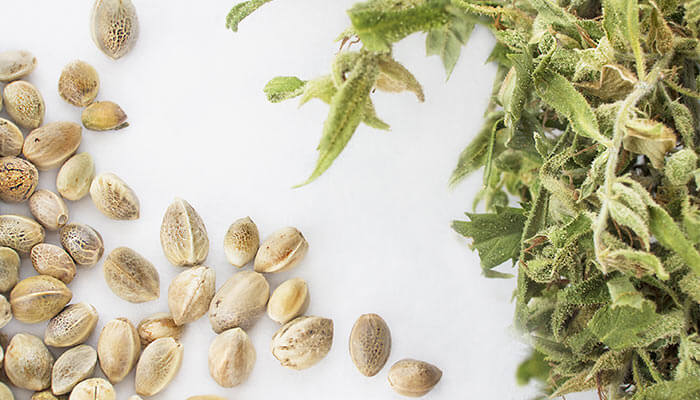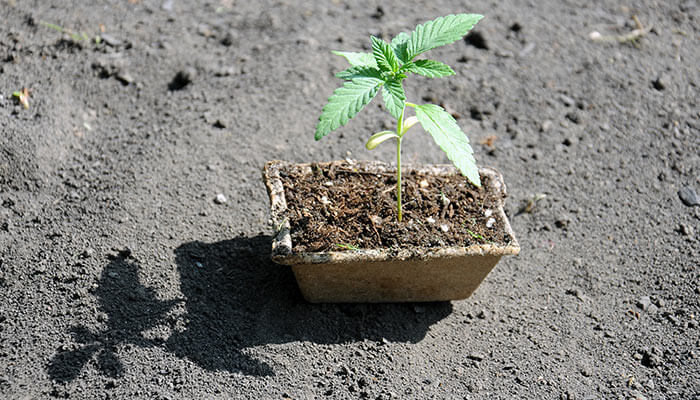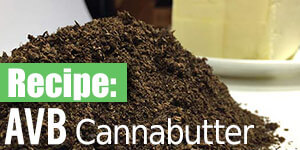Cannabis seeds are to marijuana what grapes are to wine. Each seed gives birth to a marijuana plant, but there are countless varieties with their own distinct differences. There are hundreds, if not thousands of different marijuana strains today with more popping up on a constant basis.

Exploring the Different Types of Cannabis Seeds
Each different cannabis seed will produce a uniquely different plant. Each strain has its own flavor profile, aroma, resin content, cannabinoid and terpene balance. Where the plants are grown, how they are harvested, processed and a variety of other factors decide how the bud will turn out.
Comparing marijuana strains to wine is a great way to better understand the small yet important differences.

Indica and sativa are two major differentiating factors among cannabis plants; these parallel the red and white wine varieties.
The specific genome of grape decides the type of wine produced; Merlot, Shiraz and Pinot noir are a few different types. But these types differ from vineyard to vineyard, year to year and even bottle to bottle. Marijuana is very similar in this respect, each strain, each grower, and each grow will yield a slightly different result.
We aren’t going to list all the different cannabis strains, but we will explain a few of the different types of cannabis seeds. From the regular old marijuana seeds that your parents grew, to the newer feminized and autoflower varieties that have become massively popular.
Autoflower Cannabis Seeds
Cannabis ruderalis, commonly known as autoflower, is one of the most popular types of cannabis used by home growers. Autoflower plants do not require a different light cycle in order to flower, meaning you can plant them virtually anywhere and harvest 7-10 weeks later.
Autoflower cannabis strains generally yield less than regular marijuana seeds, THC content is usually lower as well. However, the CBD content in autoflower strains is quite high, making them a perfect option for medical users.
Originating in Russia, cannabis ruderalis was first discovered in 1942 in southern Siberia. Breeders often mix cannabis ruderalis genetics with more potent indica and sativa strains, resulting in an easy to grow plant with a higher than usual THC and CBD level.
We recently had a chat with the folks over at Crop King Seeds and they told us their autoflower strains have quickly become one of their most popular sellers. With more and more baby boomers looking for alternative remedies for arthritis, chronic pain and depression, these easy to grow varieties are a perfect match for inexperienced and well-seasoned gardeners alike.
Feminized Cannabis Seeds
Marijuana plants can be either male, female or hermaphroditic. If you are growing cannabis to consume, and you aren’t a breeder, then you will want to make sure all of your plants are female. Male and hermaphrodite plants will pollinate the budding female plants and cause them to grow seeds instead of pouring their energy into growing lush, resinous buds.
It only takes 1 male to pollinate an entire crop of female plants, essentially ruining your yield. If you notice a male or hermaphrodite plant in your crop, it is important to remove it and isolate it from the rest immediately.
Feminized seeds will result in a female cannabis plant about 90% of the time, the outliers will be hermaphrodites. Regular seeds will have a 50/50 ratio male to female, making feminized seeds much more desirable to most growers.
Feminized cannabis seeds are created by breeding two female plants. Both the ‘eggs’ and pollen come from genetically female plants. This can be done a couple of different ways.
How Feminized Seeds Are Made
The natural way to create feminized seeds is to allow one female cannabis plant to stay in the flowering stage a couple of weeks beyond normal. The plant will begin to create pollen in a last ditch effort to produce at least a few seeds and reproduce.
Another way to make feminized seeds is to spray a colloidal silver solution on a female cannabis plant everyday for about 2 weeks right when it enters the flowering stage. This forces the plant to develop male pollen sacs.
There are also methods that intentionally stress out a female plant until it begins developing pollen sacs. These tactics are best left to the experts though as they are less reliable and harder to do.
Regular Marijuana Seeds
These are the seeds that most people know and love. Regular seeds require a bit more attention during their growth cycle, ensuring the light cycle changes to enter the flowering stage. They are also unpredictable when it comes to sex, expect a split between male and female plants, depending on how lucky you are.
High Times did a comparison between AK-47 seeds, testing the regular seeds vs the feminized seeds. Regular seeds resulted in a slightly taller plant, 34” to 40”, where the feminized plants were slightly shorter, 25”-34”. Despite the size difference the feminized seeds actually yielded more bud, about 12 grams more per plant on average.
There is still much debate as to whether or not regular seeds provide a more consistent genetic make-up. Some growers prefer to use regular seeds and cull the males, while other growers prefer the feminized seeds.

Germinating Seeds
This is the first, and arguably the most important part of growing a cannabis plant. It is so important because it is easy to mess up and you will end up with useless seeds that won’t grow.
Using this ‘two-plate germinating process’ you can optimize your chances of a successful cannabis seed germination.
How to Germinate Cannabis Seeds
- Take one large dinner plate and lay down a layer of moist (but not soaking) paper towel.
- Place your cannabis seeds on the paper towel, giving them plenty of space between one and other.
- Lay a couple more layers of damp (still not soaking) paper towel on top of the seeds.
- Place another dinner plate (upside down) on top. This will create a clam-shell, shielding the seeds from light. Be sure there is plenty of space between the plates so the seeds can get plenty of oxygen.
- If you are germinating the seeds in a dark room, you can omit the second plate.
- Place the seeds in a warm room (around 21° C), be sure they are far away from any direct sunlight.
- Check the seeds everyday to ensure the paper towel doesn’t dry out. If it gets dry, simply mist it with water from a spray bottle. Again, be sure not to over-water the seeds because they will drown.
- The cannabis seeds should crack and start showing a root within about 3-days, but it could take as long as 2-weeks.
- Once the roots are a few millimeters long, it’s time to transfer them to a pot filled with soil.
- Make a small hole for the seedling to sit, you want the seed to sit a few millimeters under the soil. Place the seed down root first.
- Expect the seedling to pop through the soil after one to three days.
Final Words
Once you decide which type of seed fits your preferred growing style, you can browse the massive catalogue of strains offered by the world’s top cannabis seed providers.
There are advantages and disadvantages to each style of seed, but for beginners we suggest opting for a feminized autoflower variety. This eliminates the need to be a pro in identifying the male plants that can ruin an entire crop and simplifies the growing process. Once you feel confident with your ability to grow and identify cannabis plants, branch out and experiment with different seeds and / or cloning techniques.









